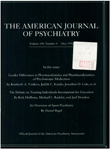Factors in the development of severe forms of tardive dyskinesia
Abstract
The authors evaluated 558 patients for tardive dyskinesia. They found that the prevalence of tardive dyskinesia was 34%. There were no differences between men and women in prevalence of tardive dyskinesia. However, severe tardive dyskinesia was found to occur more in male patients 40 years old or younger and in female patients 71 years old or older. Patients with mild tardive dyskinesia received more neuroleptics than did patients with moderate and severe forms. However, patients with moderate tardive dyskinesia had significantly more drug-free periods in their drug histories than did patients with mild tardive dyskinesia.
Access content
To read the fulltext, please use one of the options below to sign in or purchase access.- Personal login
- Institutional Login
- Sign in via OpenAthens
- Register for access
-
Please login/register if you wish to pair your device and check access availability.
Not a subscriber?
PsychiatryOnline subscription options offer access to the DSM-5 library, books, journals, CME, and patient resources. This all-in-one virtual library provides psychiatrists and mental health professionals with key resources for diagnosis, treatment, research, and professional development.
Need more help? PsychiatryOnline Customer Service may be reached by emailing [email protected] or by calling 800-368-5777 (in the U.S.) or 703-907-7322 (outside the U.S.).



